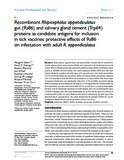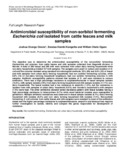Faculty of Science & Technology (FST): Recent submissions
Now showing items 4061-4080 of 4284
-
Recombinant Rhipicephalus appendiculatus gut (Ra86) and salivary gland cement (Trp64) proteins as candidate antigens for inclusion in tick vaccines: protective effects of Ra86 on infestation with adult R. appendiculatus
(School of Biological Sciences, 2011)Rhipicephalus appendiculatus gut protein Ra86 (variants Ra85A and Ra92A) and the salivary gland cement protein (Trp64) were expressed in the baculovirus-insect cell system. The recombinant gut proteins expressed as soluble ... -
Tacit knowledge transfer
(Department of Public Health, Pharmacology and Toxicology, University of Nairobi, 2010)This paper seeks to explore tacit knowledge in the light of knowledge transfer. Specifically it looks at the technique of mentoring as a process through which this highly personalized knowledge can be replicated in any ... -
Determination of carnivores prey base by scat analysis in Samburu community group ranches in Kenya
(Department of Public Health, Pharmacology and Toxicology, University of Nairobi, 2010)This study determined the prey base for four main carnivores found in Samburu Community group ranches and grazing area, Lion (Panthera leo), Leopard (Panthera pardus), Wild dog (Lycaon pictus) and Hyaena (Crocuta crocuta, ... -
People, Livestock, And Wildlife: Existing Best Natural Resource Management Practices In Naibung’a And Namunyak Community Based Conservancies.
(Department of Public Health, Pharmacology and Toxicology, University of Nairobi, 2011-01)There are a number of successful Community Based Conservation (CBC) projects in Ewaso Nyiro ecosystem. The success of CBC depends upon its acceptance by rural peoples, but few studies have examined the factors behind the ... -
Climate change and the emergence of helter-skelter livelihoods among the pastoralists of Samburu east district, Kenya
(Department of Public Health, Pharmacology and Toxicology, University of Nairobi, 2011-01)Climate change impacts livelihoods adversely in dry-lands of Northern Kenya in terms of longer and harsher droughts, shorter and intense precipitation and floods. Climate change interlocks with peoples life-worlds differently ... -
Antimicrobial susceptibility of non-sorbitol fermenting Escherichia coli isolated from cattle feaces and milk samples
(Department of Public Health, Pharmacology and Toxicology, University of Nairobi, 2010-06)The objective was to determine the antimicrobial susceptibility of the non-sorbitol fermenting Escherichia coli colonies from cattle feaces and milk samples collected from Dagoretti division in Nairobi. A total of 285 ... -
Community- and Road Kill Rabies Surveillance In Kibwezi, Kenya
(Department of Public Health, Pharmacology and Toxicology, University of Nairobi, 2010-07)We investigate the possibility of cross-infection by rabies between domestic animals and wild mammalian carnivores at a wild-domestic animal interface. The area was known to have a domestic-dog rabies but the involvement ... -
Toxigenic potential of Aspergillus species occurring on maize kernels from two agro-ecological zones in Kenya
(School of Biological Sciences, 2012)Two agro-ecological zones in Kenya were selected to compare the distribution in maize of Aspergillus spp. and their toxigenicity. These were Nandi County, which is the main maize growing region in the country but where no ... -
Effect of puparia incubation temperature: increased infection rates of Trypanosoma congolense in Glossina morsitans centralis, G. fuscipes fuscipes and G. brevipalpis
(School of Biological Sciences, 1992)Puparia of Glossina morsitans centralis (Machado), G.fuscipes fuscipes (Newstead) and G.brevipalpis (Newstead) were incubated at 25 +/- 1 degrees C, 28 +/- 1:25 +/- 1 degrees C, day:night or 29 +/- 1 degrees C throughout ... -
Isolation of Trypanosoma ssp. from wild flies through procyclic expansion in Glossina morsitans centralis
(School of Biological Sciences, 1994)Procyclic trypanosomes from wild tsetse flies were membrane-fed to Glossina morsitans centralis in order to develop an optimal technique for propagating field isolates. A 70% success rate was achieved in isolating Trypanosoma ... -
Tsetse and other biting fly responses to Nzi traps baited with octenol, phenols and acetone
(School of Biological Sciences, 2007)Octenol (1-octen-3-ol), acetone, 4-methylphenol, 3-n-propylphenol, and other potential attractants (human urine, stable fly faeces), as well as guiacol, creosol (potential repellents), were tested as baits for biting flies ... -
The insect pests of coffee and their distribution in Kenya
(School of Biological Sciences, 2011)Coffee insect pests constrain the production of anticipated high coffee yield and quality. Knowledge of common insect pests on coffee is important to facilitate the designing of effective control strategies that are likely ... -
Resistance of Predacious mites, Euseius kenyae (Acari: Phytoseiidae) to chlorpyrifos (Dursdan
(School of Biological Sciences, 2011)Several strategies are employed in management of insect pests. Among these, chemical control is a priority to most farming communities where pest incidences occur while other existing options such as biological control are ... -
Malaria Infection Increases Attractiveness of Humans to Mosquitoes
(Department of Zoology, 2005)Do malaria parasites enhance the attractiveness of humans to the parasite's vector? As such manipulation would have important implications for the epidemiology of the disease, the question has been debated for many years. ... -
Determination of total fluorine in vegetables and plants by open-flame ashing and microdiffusion : Comparison with furnace ashing and oxygen-flask combustion
(Department of Chemistry, 1988)The sample is ashed in a nickel crucible over an open flame with calcium hydroxide as the fixative; fluoride is separated by micro-diffusion and measured with a fluoride-selective electrode. The calcium hydroxide fixative ... -
Fluorosis in children and sources of fluoride around Lake Elementaita region of Kenya
(Department of chemistry, 1997)During a project to determine the fluoride levels of milk in Lake Elementaita region, the authors were astonished by the high levels of fluorosis in children living in the area. With special reference to children, a study ... -
Effect of interfering ions on hexamethyldisiloxane microdiffusion method
(2013-04-17)Acid diffusion in the presence of hexamethyldisiloxane (HMDS) enables complete recovery of ionic fluoride from standards containing varying concentrations of aluminium as one of the main interfering ions. Acid diffusion ... -
Water-labile fluoride in fresh raw vegetable juices
(Department of Chemistry, 2005)Analysis of water-labile fluoride in fresh vegetable juices from markets in Kenya was conducted by direct analysis with a fluoride ion selective electrode. Among 20 different vegetable juices, the fluoride content ranged ... -
Aluminium exposure from vegetables and fresh raw vegetable juices in Kenya
(Department of Chemistry, 2007)Drinking of fresh vegetable raw juices for both cleansing and cure therapy has become very common in Kenya. Fresh raw vegetable juices have been recommended because they can boost the required minerals and vitamins in the ... -
Rainfall runoff modeling in Yala River basin of Western Kenya
(Department of Meteorology, 2011)When rainfall is received on a watershed, depending on the ini al soil moisture content some of the water seeps underground while the excess forms surface water response. The nature of the runoff and its effects in the ...





